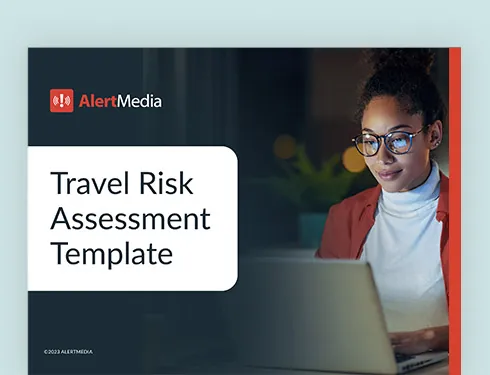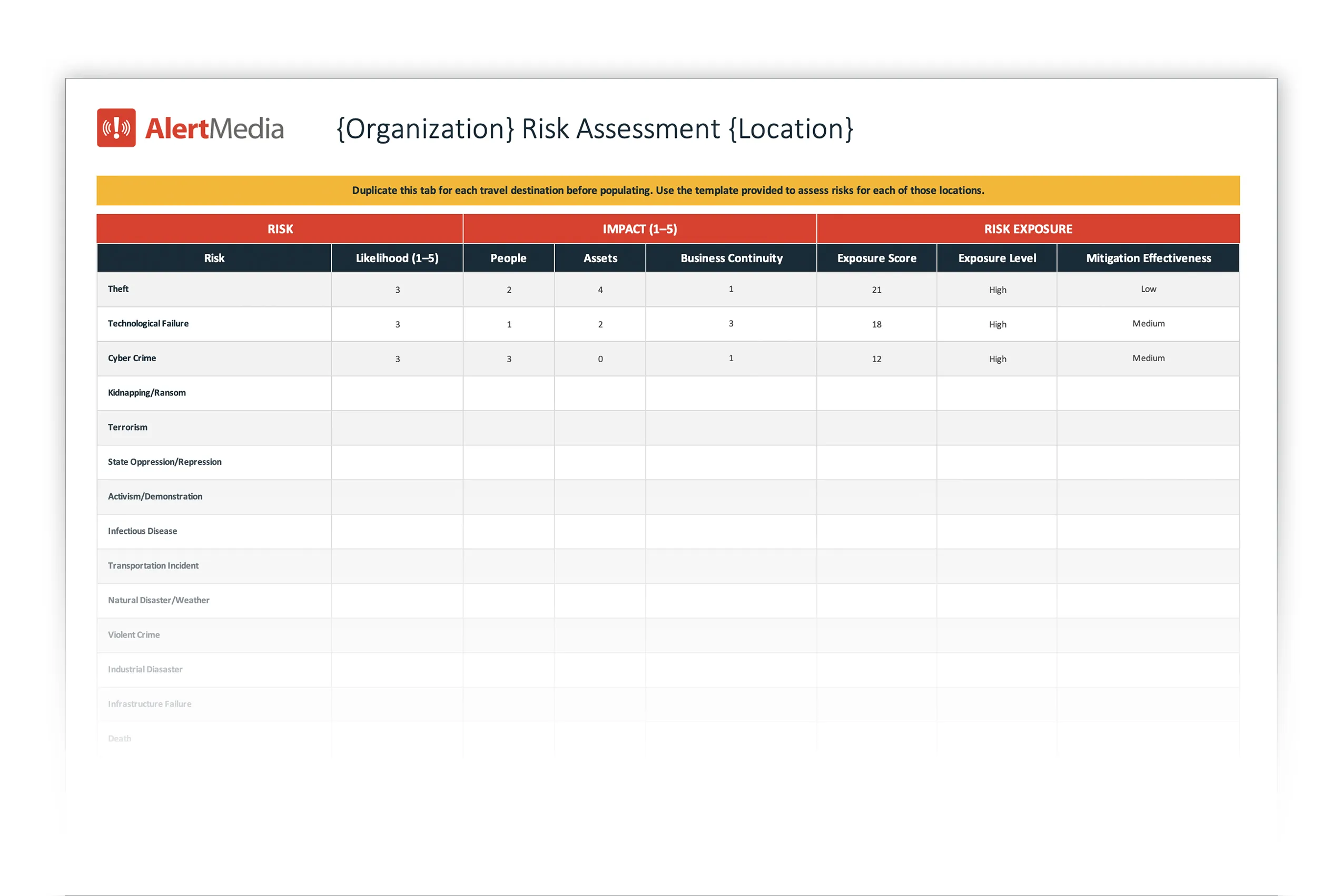
How the ISO 31030 Framework Enhances Travel Safety and Business Resilience
How do you know what your travel program is missing without a benchmark? Your traveling employees’ safety shouldn’t be left up to guesswork. Enter: ISO 31030, travel risk management standard.

While remote work has reshaped nearly every industry, it hasn’t eliminated the need for business travel. Almost 45% of respondents in a recent survey said remote work has increased the need for travel to support in-person collaboration and team building. At the same time, employee health and safety have become critical priorities, with 65% of companies enhancing their travel safety protocols.
ISO 31030 provides a comprehensive framework for travel risk management (TRM) to help companies manage these challenges. In this article, we’ll outline the standard and how your company can integrate it into your TRM plans and procedures.
Download Our Travel Risk Assessment Template
What Is ISO 31030? Managing Travel Risk for Your Team
The International Organization for Standardization developed ISO 31030 over the course of four years. It is a comprehensive standard for managing travel risk. It’s based on the more general risk management principles of ISO 31000 and follows much of the same framework.
Companies have always had a duty of care to business travelers. But in the past, there was no standardized approach to travel management. Organizations developed their own plans and processes, but the need for external standards created gaps in risk management strategies.
ISO 31030 fills that void by providing end-to-end guidance on best practices for protecting people and ensuring business continuity, including:
- Policies for travel planning and authorization
- Traveler assessment
- Evaluation of transportation options
- Destination and accommodation hazards
Are businesses required to comply with ISO 31030?
Like other standards, ISO 31030:2021 is voluntary, so there are no outright compliance requirements. However, you may need to comply with this standard (or others) to adhere to other regulations or requirements. Some of the more common examples include:
- Occupational Health and Safety Management Systems (ISO 45001): Organizations following this broader workplace safety ISO standard can use ISO 31030 to extend employee safety outside physical company borders.
- General Data Protection Regulation (GDPR): Traveling workers can pose data breach risks through devices that may be lost, stolen, or accessed in insecure environments. ISO 31030 helps organizations assess and mitigate these risks by incorporating data security measures into their travel risk management plans.
- Insurance and liability policies: Enterprises with traveling employees must demonstrate due diligence to their insurance providers to ensure coverage and mitigate liability risks. ISO 31030 provides a structured framework for managing travel risks, helping organizations document their efforts to mitigate losses.
Even if an organization isn’t bound by one of the above, implementing an ISO 31030 framework for employees who engage in business travel is still a strong best practice. The benefits extend beyond duty of care responsibilities, offering improved risk management, enhanced employee safety, reduced financial exposure, and greater operational resilience.
What are the benefits of adhering to ISO 31030?
Travel risk management is a complex field, and having a benchmark to work against better enables your company to identify gaps in your plans. It also helps establish internal frameworks you can rely on as your company grows, expands, and travels to new and unfamiliar locations.
By standardizing your travel risk management policies, you don’t just take the guesswork out of keeping your employees safe. Your company will also be able to:
- Protect your company’s personnel, assets, and data
- Facilitate doing business in high-risk locations
- Improve operational continuity and resilience
- Increase employees’ willingness to travel by ensuring their health and safety
- Enhance your organization’s reputation and credibility with current and future employees, clients, and vendors
- Limit legal and financial liability through documented compliance with international standards
- Reduce insurance costs by demonstrating more robust risk management
- Promote sustainable business growth by ensuring the company can do business in a broader range of locations
How to Implement the ISO 31030 Framework
ISO 31030 applies to companies of any size, across any industry, and regardless of the scope of their global travel. While its broad applicability might seem overwhelming, integrating it into your travel risk management strategy becomes manageable with a clear process.
In an interview on The Employee Safety Podcast, we gained expert insights from Delia Midamba, Head of Physical Security at Cloudflare. With Cloudflare’s global network spanning cities in over 100 countries, Delia understands what it takes to keep employees safe and how to implement an effective travel risk management program.
Drawing on Delia’s insights and our own experience, let’s review the critical steps to include in your travel security planning.
1. Understand your company’s operational context
The first step is to understand all factors impacting travel-related risk management. This is known as the operational context, and it includes both internal and external factors that affect employee safety and operational continuity.
Internal factors tend to be easier to address since your company has more control over them. Common examples include:
- Your organization’s industry, mission, and internal culture
- Scope and frequency of travel activities
- The backgrounds, skills, and health of employees who will be traveling
- Internal resources dedicated to managing travel risk
- Company policies, strategies, and approval processes for travel
- Intellectual property and tangible assets that employees will travel with
To streamline these processes, Delia recommends implementing pre-approved “allow lists” for low-risk destinations. These lists reduce administrative bottlenecks by allowing employees to travel to safer regions for short stays without additional approvals. You can then turn your focus to the higher-risk locations where more support is necessary.
It’s also important to be aware of regions with increased cybersecurity threats to protect company IP. Delia discusses options like providing burner devices, such as clean laptops or phones preloaded with minimal essential information. These devices mitigate the risk of human error by limiting the sensitive information they hold and reducing the organization’s attack surface.
External factors are more varied but critical to get a handle on, as they can have a tremendous impact on your employees’ safety. Factors include:
- Political and socio-economic conditions at their destination
- Reliability of infrastructure, including transportation and telecommunications
- Availability of local medical resources
- Security and quality of accommodation options
- Susceptibility to natural disasters such as hurricanes, tornadoes, or earthquakes
- Commercial and immigration regulations that could impact business trips
- Cultural or religious differences
- Effectiveness of local law enforcement
- Outbreaks of infectious diseases or viruses
Recognize that risks vary based on traveler profiles. As Delia points out, specific destinations may present additional challenges for women or LGBTQ+ employees, requiring tailored considerations and proactive safety measures.
By combining internal processes, such as pre-approved lists and data protection measures, with an understanding of external risks, organizations can better prioritize resources and provide employees with the tools and information they need to travel safely.
2. Develop risk assessment processes
Once you’ve collected data, you can build out your trip risk assessment process. At this point, the goal is to discover all potential risks business travelers might face.
The risk assessment process has three components:

- Risk identification: Start by identifying all hazardous (and potentially hazardous) conditions. While some risks will be obvious—like an ongoing civil war—many are situational and will require advance guidance. Delia discusses one such unique risk related to cybersecurity in her interview. In certain regions, officials may demand access to devices or passwords at border checkpoints. Travelers need clear guidance on how to respond in these situations but may not have this information if the risk remains unidentified.
- Risk analysis: Next, analyze the potential hazards. Who is at risk, and how likely will a negative outcome occur? For example, sending an employee into an active war zone would be high risk, while a trip to an island with a volcano that erupts once every few centuries would be much lower risk.
- Risk evaluation: Lastly, contextualize the hazards against the benefits of following through with a trip and decide on an acceptable level of risk. Following the last example, business travel to a war zone to secure a $5,000 contract would be unreasonable. Conversely, sending an employee to a client in a cold-weather region is relatively low risk as long as they’re cautious and the trip has revenue potential.
3. Evaluate risk treatment options
The next step is assessing how to treat or mitigate risks. While some hazards are unavoidable, proper planning can minimize others.
There are several ways to reduce travel risks:
- Provide your employees with training and business travel safety tips to cover basic risks.
- Ensure that your travel procurement personnel work with trusted vendors.
- Whenever possible, use accommodations that are part of the Global Secure Accreditation program.
- If you can postpone trips to avoid predictable climate risks—such as hurricane season or snowstorms—consider limiting travel to more ideal times.
- Plan carefully for travelers’ medical needs, including standard and emergency care access.
- Train employees on local regulations and customs.
- Keep track of active U.S. State Department travel advisories for your employees’ destinations.
- Develop trusted relationships with providers in remote locations for services like personal security and local transportation.
- Implement layered approvals for high-risk destinations. Delia highlights the value of limiting risk by requiring approvals for flagged locations. For example, Cloudflare prevents employees from booking travel to certain destinations until the physical security team completes a full risk assessment. Integrating these safeguards into booking systems helps avoid inadvertent travel to unsafe areas.
- When necessary, handle visa applications and government approvals well in advance to minimize potential problems.
Delia touts taking a methodical, strategic approach to travel risk policy. In her assessments, she breaks down the threats into categories and then rates each as high, medium, or low impact. She uses a risk matrix for each category to assess the specific threats, determine their likelihood, and evaluate their potential impact. This process results in an overall risk score for each category, enabling her team to prioritize their actions and implement tailored responses.
Example: Risk analysis and response for a corporate conference
In evaluating the risk impact and response options for workers attending a corporate conference, the analysis might include breaking it down into broad risk categories, weighing their likelihood and impact, and establishing a corresponding response.
| Risk | Likelihood / Impact | Response |
Health and safety
| Moderate likelihood / High impact | Moderate priority
|
Reputation
| Low likelihood / Moderate impact | Moderate priority
|
Logistical and operational risks
| High likelihood / Moderate impact | High priority
|
Company IP and assets
| High likelihood / High impact | High priority
|
Using a template during the risk assessment stage is highly beneficial as it provides a structured format to consider all potential risks associated with travel plans. It allows you to systematically evaluate threat impacts, assign risk levels, and define clear responses. This approach ensures no critical risks are overlooked and enables proactive planning to mitigate potential issues effectively.
4. Focus on effective communication
Staying connected with employees during business trips is essential for ensuring their safety and well-being. While email is a staple for updates, real-time communication tools play a critical role in maintaining strong lines of communication.
A robust travel safety app should have a few key features:
- Threat monitoring: If the risk profile changes during business travel, your employees must know immediately. These risks could range from road closures and national holidays to terrorist attacks and natural disasters.
- Location tracking: To deliver practical risk intelligence, you must know exactly where your employees are. A safety app should use GPS to identify your employee’s location and deliver location-based safety alerts that are relevant and actionable.
- Two-way communication: Regardless of the situation, you need a way to communicate with your employees. Under ideal conditions, employees should be checking in periodically. But in an emergency, they need a two-way communication platform to call for help and connect immediately with your company’s crisis management resources.
5. Adopt the right tools for a 360-degree TRM solution
While communication tools are critical, they’re only one component of a comprehensive approach to safeguarding traveling employees. A robust TRM solution provides the infrastructure to assess and address various threats.
Delia from Cloudflare highlighted the value of integrating multi-layered tools to provide a full spectrum of protection. A strong TRM solution should include the following:
- Dynamic threat intelligence: By aggregating data from multiple sources, these tools deliver timely insights into risks like geopolitical instability, cyber threats, and localized safety concerns near event venues.
- Real-time risk mapping: Advanced mapping capabilities allow organizations to visualize threats in specific regions or at event sites, helping teams make informed decisions to adjust plans, avoid high-risk areas, or secure on-the-ground support.
- Integrated security layers: Combining physical safety measures with digital tools like VPNs, firewalls, and encrypted communication ensures employees and company data remain secure, even in high-profile or public settings.
- Travel-management integration: Integrating your TRM solutions with your company’s travel management system allows you to streamline your efforts, seamlessly following employees’ digital journey as they travel to and from their destinations.
We can see how these tools work together in a hypothetical scenario:
Alex, a senior executive, is traveling to a country with a history of political unrest. Recent intelligence suggested the threat level was low, and the trip was deemed safe. He arrives for a critical business deal, confident in the company’s travel and risk management systems. However, just a day into his trip, tensions in the region boil over, and large-scale protests erupt, spreading rapidly through the city.
The company’s integrated security system springs into action. Dynamic risk intelligence flags the deteriorating situation, aggregating data from multiple sources to provide real-time updates about the growing unrest. Alerts are immediately sent to Alex and the company’s security team, who use risk mapping tools to track the protests’ locations and movements. The maps reveal that the unrest is nearing both Alex’s hotel and the venue for his meeting. Acting quickly, the team adjusts his plans through the travel-management system, arranging for a secure vehicle to move Alex to a safer area and rebooking his flight for an earlier departure.
Throughout the crisis, encrypted communication tools ensure Alex receives constant updates and instructions without compromising sensitive business information. The combined system allows the company to keep Alex out of harm’s way while ensuring the deal proceeds remotely. It also tracks the response for review and improvement after the fact.
6. Maintain and review records
Travel risk management isn’t a one-time task; it’s an ongoing process that evolves alongside your company’s internal and external contexts. Your TRM strategy should adapt to ensure employee safety and operational resilience as your staff, operations, or risk landscape changes.
In her interview, Delia emphasized the importance of building flexibility into your TRM program by using data-driven strategies to refine processes. This approach includes:
- Post-travel debriefs: Any time someone from your company travels, collect their feedback on the trip. Specifically, request feedback on their transportation, accommodations, business contacts, and local conditions. The more data you can collect about where your company does business and how your employees get there, the more thoroughly you can vet and begin to optimize the situation. According to Delia, focusing on recurring patterns or specific challenges can help your organization proactively refine its travel protocols and address problem areas.
- Incident reports: If an employee faces a security risk or health hazard, collect as many details of the event as possible. Delia recommends using these reports to analyze trends and identify gaps in your risk mitigation strategies, ensuring lessons learned inform future strategy.
- Training and education: Your most targeted training resource is using actual data from your company’s travel records. Use it to develop documentation and supplement webinars or other training materials. Delia highlights how engaging employees with scenario-based training—like tabletop exercises—builds confidence and ensures they’re better equipped to respond to emergencies.
Limitations and Challenges of ISO 31030
These six steps will allow you to implement an ISO 31030 framework to protect your traveling workers and the assets they carry with them. However, with every change, there are bound to be a few growing pains. Overcoming challenges with ISO 31030 will require strong organizational commitment, clear communication, and continuous refinement of your travel risk management processes.
Overcoming ISO 31030 limitations and challengesWhile ISO 31030 is a big step forward for corporate travel safety, it has limitations. Like with any standard, implementation can be a barrier to effective adoption. Here are some common roadblocks and solutions to overcome them: | |
| Problem | Solution |
| Uncertainty about legal liability and compliance requirements |
|
| ISO 31030 is too abstract and comprehensive |
|
| Resource constraints for smaller organizations |
|
| Misalignment among stakeholders in larger organizations |
|
Elevating Your Company’s Travel Risk Management Plans
Ideally, a business traveler’s worst hazard would be indigestion from overpriced airport food. Unfortunately, most trips involve more risks than that. Whether your employees drive to a client two hours away or fly around the world, they count on you to make their travel as safe as possible.
The ISO 31030 standard defines travel risk management as a defined and structured process. Using its principles and framework, your company will be able to identify, assess, and mitigate the risks your employees face and get them home safely from their travels.





